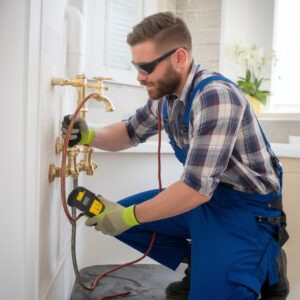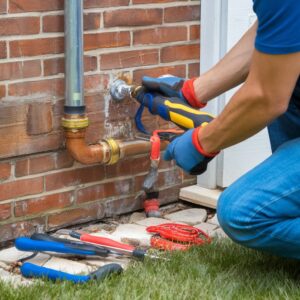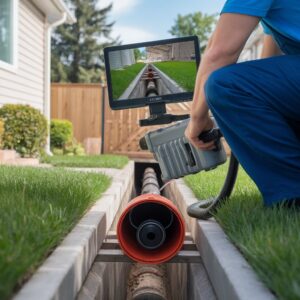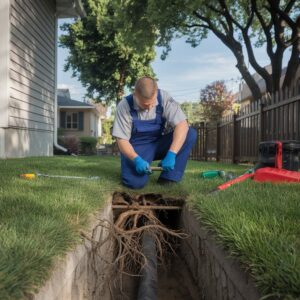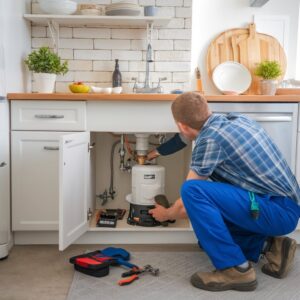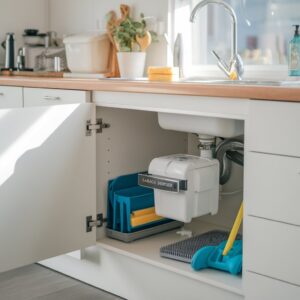Installing a heat pump requires careful planning and execution to guarantee efficiency and longevity. The process begins with selecting the right unit and evaluating the building’s thermal and electrical capacities. Precise installation steps include properly mounting indoor and outdoor units and modifying air ducts for peak airflow. Securely connecting refrigerant lines and performing pressure tests are essential. Finally, evacuating air and moisture confirms system readiness. These meticulous steps assure compliance with safety standards.
Key Takeaways
- Conduct a Manual J load calculation to ensure the heat pump is properly sized for the building’s needs.
- Verify compatibility of the existing electrical and duct systems with the new heat pump requirements.
- Carefully follow the installation instructions for mounting and connecting indoor and outdoor units.
- Connect refrigerant lines using proper brazing techniques and conduct pressure testing for system integrity.
- Train technicians to handle refrigerants according to environmental regulations and safety protocols.
Steps to Take Before Your Heat Pump Installation
Effective HVAC planning is vital for optimizing the efficiency and longevity of a heat pump installation.
Prior to commencing the installation, an installer should conduct a thorough assessment of the building’s thermal characteristics, electrical infrastructure, and ventilation needs to guarantee compatibility and performance.
Additionally, verifying clearances, accessibility, and compliance with local codes will preemptively address potential issues, thereby streamlining the installation process.
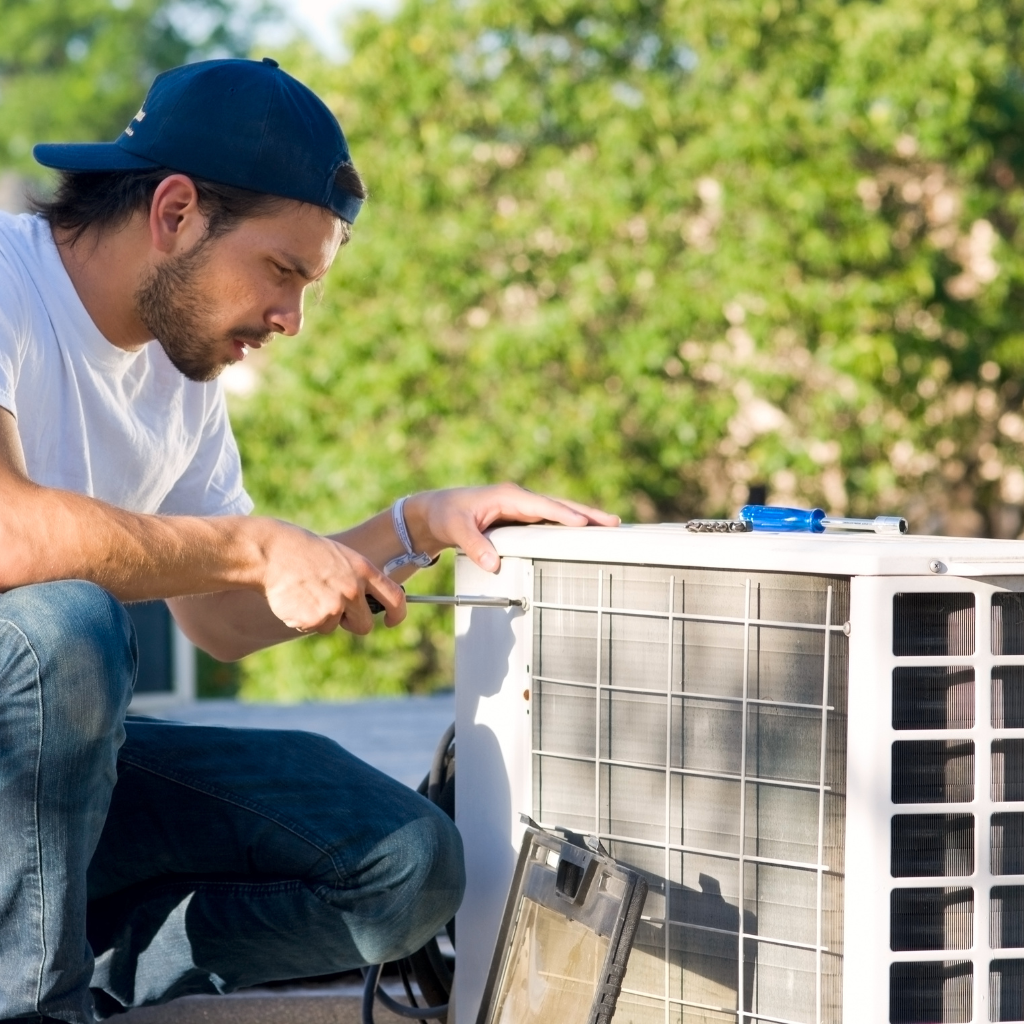
How can HVAC planning improve your heat pump installation?
Careful HVAC planning greatly enhances the efficiency and effectiveness of a heat pump installation. By evaluating the heating and cooling needs, an HVAC contractor can guarantee peak performance and energy efficiency. Crucial steps include conducting a Manual J load calculation, which determines the correct size for an air source heat pump. This process prevents over or under sizing, both of which can lead to inefficiencies and increased costs. Reviewing the duct system is also essential to guarantee seamless airflow. This thorough HVAC planning integrates smoothly into the installation process, contributing to overall home improvement.
| Factors Considered | Benefit |
|---|---|
| Manual J Calculation | Proper Sizing |
| Duct System Evaluation | Improved Airflow |
| Energy Efficiency | Reduced Costs |
Meticulous preparation secures a successful installation.
What should a heat pump installer check before starting?
With a thorough HVAC plan established, the next phase involves the installer conducting several pre-installation checks to confirm a smooth heat pump installation.
The heat pump installer must meticulously evaluate the home’s electrical system to verify compatibility with the heat pump system’s requirements.
Additionally, inspecting the existing air duct network for any leaks or obstructions is vital to optimize airflow and efficiency.
A thorough assessment of the refrigerant lines for wear and proper sizing is essential to prevent future issues. The thermostat and air handler need to be verified for compatibility with the new heating system. Finally, confirming the outdoor unit’s location is free of obstructions will facilitate proper operation.
- Electrical System Compatibility
- Air Duct Integrity
- Refrigerant Line Condition
- Outdoor Unit Clearance
How Does the Heat Pump Installation Process Work?
Installing a heat pump involves several important steps, such as setting up the indoor and outdoor units, connecting the refrigerant lines, and verifying that the electrical system is compatible.
HVAC technicians handle refrigerant lines with rigorous safety protocols to prevent leaks and guarantee efficient operation.
Proper sizing of the heat pump is essential to optimize energy efficiency and meet the specific heating and cooling demands of the space.
What does a heat pump installation typically involve?
Installing a heat pump involves a series of precise steps to guarantee ideal functionality and efficiency. Initially, the heat pump installation process starts with selecting the appropriate unit—whether a ductless mini-split heat pump, air-source heat pump, or ground-source heat pump.
Precise installation instructions are followed to ascertain seamless integration with the home’s electrical system and existing HVAC system. Air duct alterations may be necessary for maximum heat and cool distribution.
- Guarantees maximum comfort: A well-installed heat pump optimizes comfort across seasons.
- Reduces energy costs: Efficient systems lower utility expenses, offering financial relief.
- Enhances eco-friendliness: Proper installation supports sustainability efforts.
- Boosts property value: A modern, efficient system increases home value.
These steps are critical to achieving a reliable and effective heating and cooling solution.
How do HVAC companies handle refrigerant lines safely?
Handling refrigerant lines safely during the installation of a heat pump involves meticulous procedures that HVAC companies adhere to in order to confirm both efficiency and safety.
During HVAC installation, technicians meticulously manage refrigerant lines to prevent leaks and maintain refrigerant safety. Proper brazing techniques are employed to secure connections, while pressure testing verifies system integrity.
HVAC companies utilize vacuum pumps to evacuate air and moisture, essential steps to sustain system efficiency. Careful routing of refrigerant lines minimizes potential damage when the system is operating.
Technicians are trained to handle refrigerants in compliance with environmental regulations, vital when they install one. Additionally, integrating refrigerant lines correctly with the air conditioner guarantees peak performance and longevity of the heat pump system.
Why does proper sizing matter when you install a heat pump?
Proper sizing is essential during the installation of a heat pump to guarantee peak performance and energy efficiency. A new system that is too large or too small can lead to inefficiencies, inadequate heating and cooling, and increased operational costs.
Air source heat pumps must align with specific home needs, considering factors like climate and insulation. During the installation process, precise measurements ascertain that the unit meets existing heat pump standards or new requirements.
- Incorrect sizing leads to frequent cycling, which accelerates wear and reduces lifespan.
- Oversized systems can result in uneven temperature distribution, causing discomfort.
- Undersized units struggle to maintain desired temperatures, leading to increased energy consumption.
- Proper sizing optimizes performance and efficiency, meeting the specific demands of heating and cooling systems effectively.
How Do Heat Pump Systems Work and Which One Is Right for You?
Heat pump systems are categorized primarily into ground source, air source, and geothermal types, each with specific installation requirements and operational efficiencies.
Ground source heat pumps necessitate the installation of a network of pipes underground, leveraging the constant temperature of the earth to provide heating and cooling. While highly efficient, this type of heat pump can cost more upfront due to the extensive excavation required to install your new heat pump system.
In contrast, air source heat pumps operate by extracting heat from the air, making them a popular option because they are easy to install and budget-friendly. However, their performance may be slightly affected during extreme weather conditions, such as snow and ice, which can impact outdoor units if not properly maintained.
Meanwhile, geothermal heat pumps utilize the stable underground temperatures to efficiently regulate indoor climates, offering a reliable solution for long-term energy savings.
What’s Involved in Installing a Ground Source Heat Pump at Home?
Installing a ground source heat pump in a home involves a meticulous process that begins with site evaluation. The installation process requires evaluating the soil and land availability outside of your home for geothermal heat pumps.
This source of heat is harnessed through loops buried underground, which connect to the heat pump unit. To effectively heat your home, professionals install the outdoor components and integrate them with the indoor system via ductwork. This method maximizes heating and cooling your home efficiently.
- Precision and care are essential in the installation process.
- Energy efficiency is achieved through sustainable heating.
- Long-term savings from reduced energy bills.
- Environmental benefits contribute to a greener home.
This thorough approach guarantees peak performance and energy efficiency.
What makes air source heat pump systems a popular option?
Air source heat pump systems have gained popularity due to their versatility and efficiency in various climates. These systems are designed to heat efficiently and cool homes by moving heat between the indoors and outdoors.
The installation is generally simpler than that of many other heating and cooling systems, making it an attractive option for homeowners looking to install heat pumps. Air source heat pumps can integrate with central air systems, providing uniform warm air distribution while minimizing energy consumption.
By using a thermostat to regulate temperature, they guarantee peak comfort. Their energy-saving capabilities are enhanced by sealing potential air leaks, increasing efficiency.
How do geothermal heat pumps heat and cool your home?
Curiously, geothermal heat pumps function by harnessing the stable temperatures found beneath the earth’s surface to heat and cool a home efficiently.
Utilizing ground source technology, these systems transfer geothermal heat through a series of pipes installed underground. The installation process is intricate, requiring precise placement to guarantee maximum efficiency.
Inside your home, the system distributes either cool air or warmth through air systems, while the hot water cylinder provides additional heating. Proper insulation is critical to maintain ideal temperature regulation.
- Sustainable comfort: Embrace the earth’s natural energy for a stable climate.
- Economic savings: Enjoy lower energy bills with efficient operation.
- Eco-friendly choice: Reduce carbon footprint by using renewable resources.
- Reliable performance: Trust in a system that operates consistently year-round.
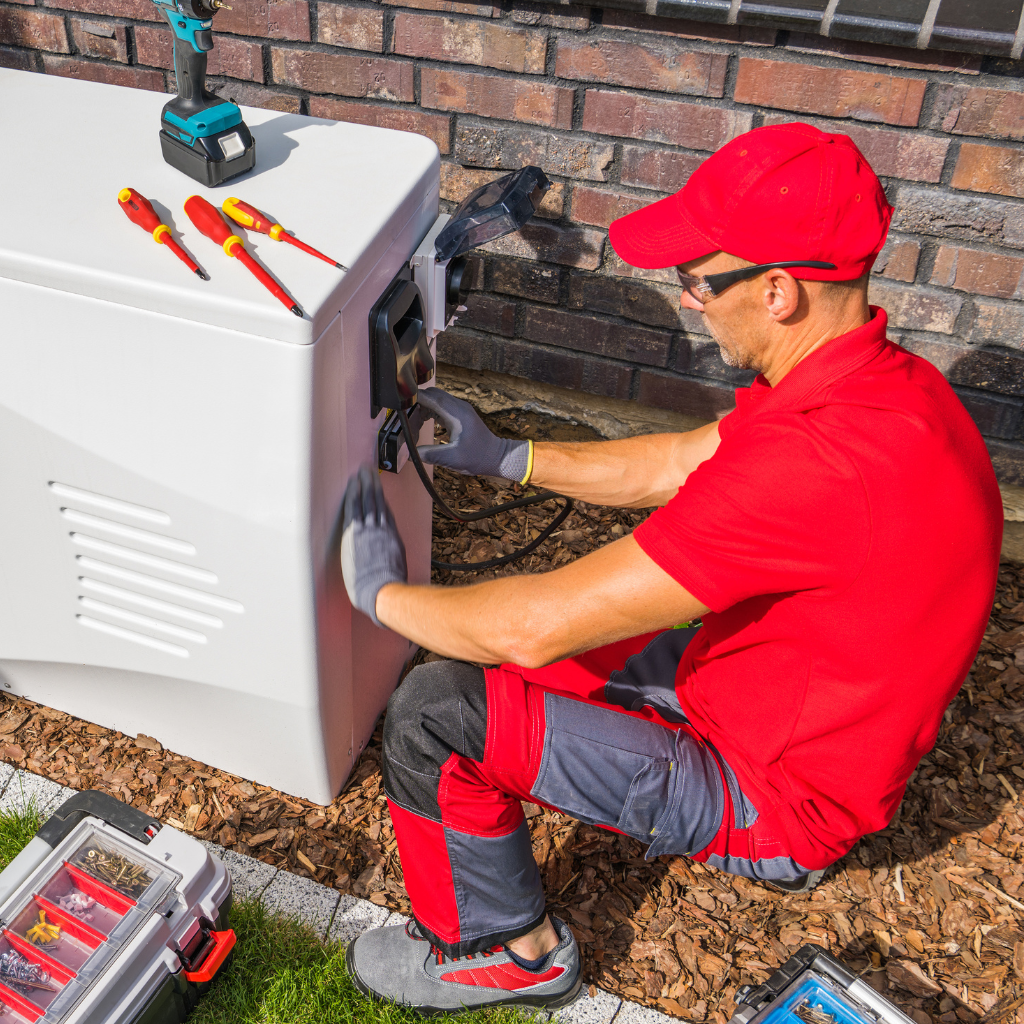
What Should You Expect When Replacing an Old Heat Pump?
When replacing an old heat pump, one can anticipate the installation process to typically take between one to two days, depending on the complexity and any required modifications to existing infrastructure. However, bad installation can lead to inefficiencies and system failures, so it’s crucial to hire experienced professionals when installation begins.
A new heat pump system can enhance cooling efficiency by utilizing advanced compressor technology and variable-speed fans, providing consistent temperature control and reduced energy consumption. These systems are designed to cover installation needs across various home types, and most technicians are able to install them even in homes with older ductwork, though some situations may still prove difficult due to limited access or structural limitations.
Additionally, modern heat pumps often feature improved refrigerants and smart thermostats, contributing to more effective and tailored cooling solutions.
How long does installing a new heating system take?
Replacing an old heat pump with a new heating system typically involves a multi-step process that can take anywhere from one to three days, depending on various factors.
When the installation team begins, they must assess the existing HVAC setup, including the furnace and air conditioner, to determine the time to install the new heat pump.
The installation process requires precision and coordination to guarantee peak efficiency and functionality.
- Anticipation: Waiting for the installation team to arrive and start the process.
- Discomfort: Temporary loss of heating or cooling during the installation.
- Excitement: Looking forward to a more efficient and reliable system.
- Relief: Completion of the installation process restores comfort to the home.
Each step is critical to guarantee the new heat pump operates effectively.
How can a new heat pump cool your home more effectively?
A new heat pump can cool a home more effectively due to advancements in technology that enhance energy efficiency and performance. Selecting the right heat pump for your home guarantees ideal cooling.
Modern units utilize different heat transfer methods, including ground source heat, which efficiently maintains indoor temperatures. When installing a new system, it is essential to follow precise steps on how to install a heat pump, making sure all components are correctly fitted.
This includes calibrating the thermostat to maximize energy savings and comfort. Properly installed, these units offer an efficient way to heat and cool homes. Regularly check the thermostat settings to maintain desired temperatures.
A well-installed heat pump can markedly improve the cooling efficiency, reducing energy consumption and enhancing comfort.
How Can a Heat Pump Improve Your Home Long-Term?
A heat pump is an efficient long-term home improvement that reduces energy consumption and utility costs through its dual heating and cooling capabilities. A heat pump is straightforward to install in many modern homes, especially when replacing outdated systems.
Compared to traditional air conditioners, air source heat pumps provide superior energy efficiency by transferring heat rather than generating it. When it’s time to replace older HVAC equipment, opting for a heat pump can deliver both performance and savings.
Additionally, a heat pump contains components that can be paired with a hot water cylinder to further enhance efficiency by supplying domestic hot water, thereby optimizing the overall energy usage of the household.
Why is a heat pump for your home a smart home improvement?
Given the growing emphasis on energy efficiency and sustainability, integrating a heat pump into a home emerges as a strategic improvement that delivers considerable long-term benefits.
A heat pump offers an efficient alternative to an old system, providing new heat and replacing cold air effectively. Professional installers ascertain precise setup, optimizing thermostat settings for maximum efficiency and minimizing operational costs.
This home improvement not only reduces energy consumption but also greatly decreases utility bills.
- Increased Energy Efficiency: Save on energy costs as the system efficiently replaces older models.
- Lower Your Carbon Footprint: Support environmental sustainability by using less energy.
- Enhanced Comfort: Maintain a consistent indoor temperature by efficiently managing cold air.
- Long-term Savings: Lower utility costs over time compensate for initial installation expenses.
How do air systems heat pumps compare to an air conditioner?
When evaluating the differences between air systems, heat pumps, and air conditioners, one must consider their operational mechanisms and long-term benefits. A heat pump not only provides a way to heat and cool efficiently but also consolidates the role of a furnace and air conditioner. During installation, the type of heat pump selected impacts performance and efficiency, unlike air conditioners that solely cool, heat pumps run throughout the year, offering dual functionality. Setting up the thermostat correctly optimizes energy use. The table below highlights key emotional responses:
| Feature | Heat Pump Emotion | Air Conditioner Emotion |
|---|---|---|
| Dual Functionality | Satisfaction | Limitation |
| Energy Efficiency | Economical Comfort | Seasonal Efficiency |
| Installation Impact | Longevity Assurance | Seasonal Setup |
| Operational Scope | Year-Round Reliability | Summer Relief |
How does a hot water cylinder support your new system?
Integrating a hot water cylinder with your heat pump system enhances overall efficiency and performance. This support system guarantees optimal heat distribution and provides seamless temperature control.
During the installation process, the compatibility between the heat pump and the hot water cylinder is essential for efficient operation. The integration allows for substantial energy savings by utilizing excess heat generated by the pump, reducing reliance on additional heating sources.
- Enhanced Efficiency: By using the hot water cylinder, the system minimizes energy waste.
- Consistent Temperature Control: Provides stable heat distribution across the home.
- Energy Savings: Lower utility bills due to the efficient operation of the integrated system.
- System Compatibility: Guarantees that the heat pump and cylinder work cohesively for optimal performance.
This strategic integration yields long-term benefits for homeowners.
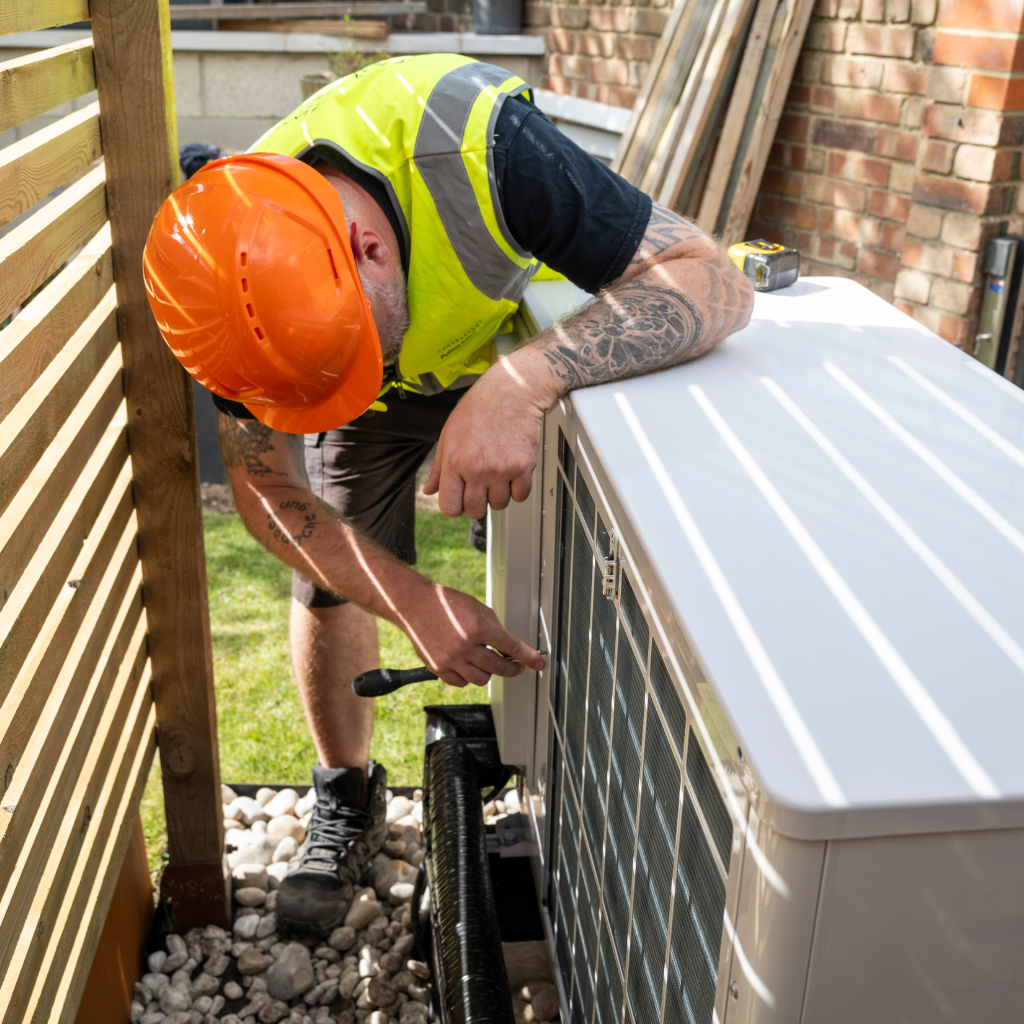
Conclusion
In summary, the meticulous installation of a heat pump is essential for peak performance and longevity. By selecting the appropriate unit and adhering to precise installation guidelines, including secure refrigerant line connections and rigorous pressure testing, the system’s integrity is maintained. Proper air evacuation and compliance with safety and environmental standards guarantee the system operates efficiently. Ultimately, a well-installed heat pump enhances thermal comfort and energy efficiency, offering long-term benefits for the building’s occupants.

